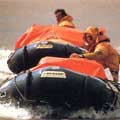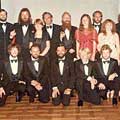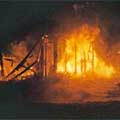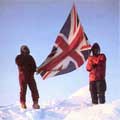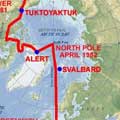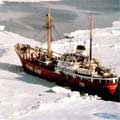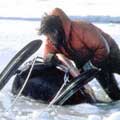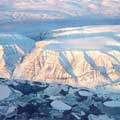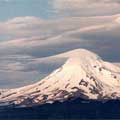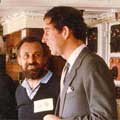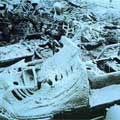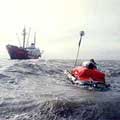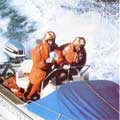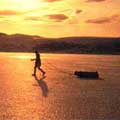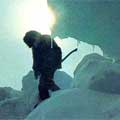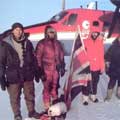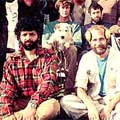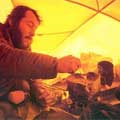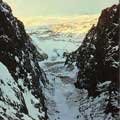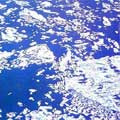Part 3: The Arctic
May 1981 – August 1982
Having completed the Antarctic crossing in April 1981, and after a brief visit to Captain Scott’s hut at Cape Evans and a stopover at Campbell Island (the first British ship to do so since World War 2) the expedition Team travelled north, up the Pacific, on board Benjamin Bowring and set up a number of trade exhibitions along the route in Auckland, Sydney, Los Angeles and Vancouver. Much to everyone’s sadness, following his huge contribution to the success of the expedition, Oliver Shepard felt obliged to leave the Land Team at this stage due to family commitments at home. This left Ran Fiennes and Charlie Burton to tackle the Arctic crossing alone. Although they were facing the most hazardous part of their journey, and despite a strong recommendation from the Executive Committee in London to take a third person with them, they both felt that if Ollie couldn’t be with them, they would prefer to travel alone.
The Northwest Passage
The Benjamin Bowring took eleven days on the voyage from Vancouver, and anchored off the Yukon Delta in 25 feet of water on 30th June. Next morning they put the two Dunlop expedition craft in the water and loaded them with equipment and stores for their journey up the Yukon. Then Ran, Charlie and Bryn Campbell (the Observer photographer who had spent some time with Transglobe in Antarctica and was to photograph their journey across Alaska to Tuktoyaktuk) boarded and they set off for the Delta in a moderate swell. As they neared the land, the swell increased and they encountered breaking waves. One such wave capsized Charlie’s boat and, having righted it, the team were obliged to return to the ship to dry out the engine and Charlie’s gear. In view of these conditions, it was decided to move the ship north in order to approach the Yukon Delta from a different aspect. The second attempt proved more successful.
As they had entered the mouth of the Yukon, they had been met and escorted in by a local Boston Whaler, an open 18-footer with a lot of freeboard and a reputation for being very good in rough water. The team’s experience with the inflatables, and their subsequent slow progress up-river led them to re-think their transport requirements, both as regards boats and engines. Ran telephoned urgently to Simon Grimes, who was still in Vancouver; some rapid negotiations took place. The American bankers Morgan Stanley came forward as new sponsors, and with their help an 18-ft. Boston Whaler called ‘Outrage’ was acquired and arrangements set in hand to get her up to Inuvik, where she became the ‘Morgan Stanley’. Simultaneously, urgent negotiations were in hand with Outboard Marine, the manufacturers of Evinrude, for the supply of more powerful engines; and at Tanana, the next staging point after Galena, two 60-h.p. Evinrudes were made available by the Company’s representative there, Jake Birkett.
Virginia Fiennes, who had meanwhile motored in the Expedition’s Land Rover from Vancouver to Dawson accompanied only by her terrier Bothy, took part in and co-ordinated all these arrangements.
At Inuvik the Morgan Stanley, with two new 60-h.p. Evinrude engines awaited them, having been airlifted there by North-West Territorial Airways. She was duly loaded and on Monday 20th July the journey to the mouth of the Mackenzie River, Inuvik to Tuktoyaktuk, took eight hours, the Morgan Stanley proving fast, dry and comfortable.
As soon as they arrived, the whole team buckled to and prepared the Morgan Stanley for her 3,000-mile voyage; and with such effect that Ran and Charlie were able to set off the next morning, 21st July, shortly before 10 o’clock. The Northwest Passage lived up to its reputation and provided thick fog.
On 11th August, they reached Gladman Point from Cambridge Bay, pushed on immediately and 3½ hours later made their landfall at Gjoa Haven. Karl Zberg had meanwhile flown Virginia and Simon to Resolute, where they had established the next base, and he had also laid down fuelling supply points at Pasley Bay and Fort Ross on the Boothia Peninsula, and Aston Bay on Somerset Island.
The ice build-up had been caused by south-westerly winds, blowing against the prevailing current, and these winds persisted as the Morgan Stanley set out in fog on 13th August, heading north towards Spence Bay. There they had to wait for the wind to change. Fortunately it soon veered round to the north-west and strengthened, and they were able to thread their way through the floes to Resolute.
There it was discovered that the originally planned northward route was completely blocked by ice, and as a result Ran decided to follow an easterly route from Resolute along the south coast of Devon Island. They reached Grise Fjord, on Ellesmere Island, on 28th August. Since the originally planned route to the east of Ellesmere remained blocked with ice, Ran had no alternative but to proceed west from Grise through Jones Sound then north through Hell’s Gate into Eureka Sound. There they found open water where they could give the Morgan Stanley a chance to show her paces. Open water persisted all the way to Tanquary Fjord, which they reached on 31st August, a full six weeks ahead of schedule. They covered the 900 miles (1450 kms) from Resolute to Tanquary in just six days.
From Tanquary the 150 miles (240 kms) had to be crossed on foot. They arrived at Alert on 26th September.
The Arctic Ocean
Following nearly 5 months overwintering, Ran and Charlie left Alert, fit and in good heart, on February 12. Their plan was to travel some 100 miles (160 kms) westward along the shore, and then to turn north on to the ice. Though the snow cover was poor, which caused the sledge runners to grate on the bare rock, they made fair progress and reached Clement Markham Fjord, where they were to turn northwards, on February 17. All along the shore they had passed alongside huge ice ridges, between 30 and 40 feet high (9 – 12 m), piled up by the force of the current and wind. That night they camped under such a ridge, and prepared to axe their way through.
During the next two days, working to exhaustion, they had cleared only 800 yards (730 m), and moved camp to the end of this in case the 15-knot wind and temperatures of -42° F (-41° C) should make it impassable. The next day they managed only 200 yards (183 m), and in moving camp to the end of the strip shattered the drive shaft of one of the Alpine skidoos. Conditions like these had so delayed progress during the 1977 training journey as to put it seriously at risk, and Ran therefore decided to put into operation an alternative plan.
During the winter at Alert he had designed and constructed pulks that could each carry 200 lbs (90 kg) and be manhauled. In case of necessity, they could also be converted into canoes to cope with small stretches of open water. He radioed to Alert for these to be delivered in the Twin Otter, together with lightweight tents and radio equipment, snowshoes and skis. It was still incredibly hard work over the ridges, but in an hour they were able to cover the same distance as had taken two days with the skidoos. Nevertheless daily distances varied between one and four miles.
Ran reported: ‘Incredibly hard work. Sweat like hell and it turns to ice between the layers of clothing. Still between -38° and -45° F (-39° to -43° C), blowing snow and ice crystals over everything and sticking to outside of clothes. Still have to walk ahead to find best route and then walk back to start axing. Axing not as difficult as for vehicles but still hard work and often miss with axe or axe bounces off granite-hard ice — have holes in boots. Nose, thumbs and feet particularly cold. Torch batteries minimum so make camp while a little twilight left but clumsy in dark tent. Have to remove and dry all clothes. Melting ice dripping on sleeping bags and making steam in tent.”
And when, by the last day of the month, they eventually emerged from the worst of the ridged area, they found that as a result of the unusually mild winter, the newly formed ice had taken the shape of the waves, and progress was almost equally painful over lumps, humps and frequent piles of ice rubble sometimes 15 feet high (4½ m). Their spirits were lifting, because of the prospect of better travelling and also because the twilight had at last begun to give way to sunlight as the sun lifted itself above the horizon. What then happened is vividly described by Joan Cox in one of her monthly newsletters: “Back at Alert,” she writes, “Simon Grimes prepared the Elan skidoos and fuelled them; he packed the sledges and left them outside the garage, but he had second thoughts about the skidoos, thinking they might be difficult to start if the weather deteriorated, and he kept them inside the garage. Two hours before they were to be loaded on to the plane Ginny was awakened by a call from the Canadian Base: Did you know one of your huts is on fire? She rushed out, not stopping to put on her outdoor clothing, and tried to open the garage door. But already one side of the hut had burnt away and everything inside was in flames.”
“She shouted above the roar of the fire to Simon and Karl. They pulled the kit away from the outside of the hut and tried to save the scientific equipment which was housed in a lean-to. They managed to save some ice rations, one tent and two empty sledge boxes.”
For several days after the fire there were no messages from Virginia; but it was known at the London Headquarters that the Canadian firm of Bombadier had replaced the lost Elans (250 cc.) with Citation skidoos (277 cc.), which reached Alert on March 7, only three days after the fire. Unfortunately, like the Elans, the Citations were too light to tow the sledges, and so Ran asked Karl Zberg to recover the Alpines (640 cc.) from Markham Fjord. After four days of white-out when no movement was possible either for the plane or the team, Karl flew out the Alpines on March 14. By 4 p.m. that day Ran and Charlie were on their way again, with the Alpines towing the British Steel sledges. In three hours they made 11 miles, passing through pressure ridges, avoiding one big lead and making good speed over the ice paddocks (flattish floes surrounded by low pressure walls). But the snow of the past four days had disguised the surface and made it impossible to assess the thickness of the ice. Thus Ran drove straight into a lead made invisible by a covering of snow. As he felt the Alpine tilt under him he leapt off backwards on to the edge of the firm ice, and ran back along the towline. With Charlie’s help he managed to rescue two boxes from the sledge as it was dragged by the sinking skidoo into the icy water. When the sledge sank, a third box floated to the surface, and they were able to retrieve it.
The three salvaged boxes contained between them the bare bones of a set of survival equipment — the radio, Kern theodolite, a tent bag and one tent sheet. The rest of the navigational kit, charts, the tent, heater, cooker, food, the Nikonos underwater camera and all the film taken since the last visit of the aircraft were lost.
Thus the found themselves at night on the ice in a temperature of -25 degrees, only one tent bag and a flysheet, no tent, no hot drinks, no food and the ice in the immediate vicinity too fragile for an aircraft to land. At Alert, Karl loaded the plane with a tent, heater, cooker, rations, Alpine skidoo and sledge. Later a BBC reporter from radio news spoke to Ginny and learned that not only had the aircraft located the men, but that they had spent the morning searching for a landing place, and had found one 400 yards long (365 m), which had enabled the plane to land.
Their morale slightly boosted by the fact that it was by then light for fifteen hours out of the twenty-four each day — and no doubt also by their escape and prompt re-supply — Ran and Charlie set off again and three days later found themselves in dire straits — stranded on a floe with open water all round. The temperatures had risen to -6° F (-21° C).
At Alert gale force winds had buffeted the aircraft while it was grounded, swinging it through 180 degrees and damaging a wing. A spare part could not be flown in in less than a week, and so Gerry Nicholson (the Expedition’s flight engineer) and Karl Zberg (who has an engineer’s licence as well as a pilot’s) did a careful first-aid job on it so that they could fly north of the team and assess the area. What they saw was not encouraging. The mildest Arctic winter on record had resulted in wide stretches of open water where normally there should have been unbroken ice. But suddenly the 60-knot wind dropped, the temperature plunged to -34° F (-37° C), and the leads closed up, enabling Ran and Charlie to move. They had to make a two-mile detour to the south, before heading once again northwards.
By March 25 they were less than 300 miles (500 kms) from the Pole. Ran reported a temperature of -40° F (-40° C), wind speed of 40 knots. “Very cold travel. Good paddocks. Lots of blue rubble. Ice rain hurts the eyes. At midday heard and watched new ridge form moving approximately two miles an hour. Camped on a one-acre paddock. At 21.30 hrs. tent hit by shock wave of wind and impact spilt Charlie’s coffee.”
During the next few days they made good progress in spite of high winds and near white-out conditions. Ran reported: “Our noses, cheeks and eyelids are frostbitten, our fingers cracked. We wear two separate face masks covering everything but the eye area and a hole by the mouth. The mouth hole freezes with an inch of ice all round. . . Three days ago, in the tent, I took off my face mask and bunches of hair with skin and blood attached came away. The area has now gone septic so I am taking penicillin pills. But the discomforts of travel and life at -40 are all desirable since the low temperatures may stave off the early break-up of the sea ice which could mean for us a year’s delay in completing Transglobe as well as a hazardous situation in the short term.”
By the end of March they were still 230 miles (370 kms) from the Pole, but eleven days later they reached it, four days earlier than they had originally planned.
Having reached the North Pole on Easter Day, Ran Fiennes said, “I find the Arctic Ocean a more frightening place than any region I have travelled through, certainly more hostile than Antarctica (where) I never felt insecure for long. After all, at the end of the day you put up your tent and slept soundly having checked the snow beneath. Not so in the Arctic Ocean. I write this 500 miles out to sea squatting in a flimsy 15-lb (7 kg) tent. We have no boat, no lifejackets and no flotation; indeed, nothing which is not totally necessary to the immediate job — which is to get the hell out of here as fast as possible, carrying as little weight as safety requirements dictate”.
The twenty-four hours they spent there in order to make quite certain of their position were clearly nerve-racking for Ran, who wanted to take advantage of every single hour to push away southwards while the ice still held. But the delay enabled Karl Zberg to fly in David Mason and Simon Grimes, whose sterling work in supply and maintenance was thus rewarded — not to mention Bothy the Jack Russell terrier who became the first dog to have visited both Poles. Ran planted the Union Jack, the Blue Peter, the SAS and the Bowring and Marsh & McLennan flags, though within twenty-four hours all five would have moved away with the Trans Polar Drift.
Bothy, of course, was not the only record-breaker. Transglobe is the first team to have visited both poles in one expedition; the fastest team across the Antarctic and the first team to have navigated the Yukon and Northwest Passage in one season. Their arrival at the North Pole meant they were close to achieving the first surface/ice crossing of the Arctic Ocean via the North Pole using mechanical transport. However, to do this they still had some 600 miles to cover on their journey towards the ice edge in the vicinity of Spitzbergen.
Ran and Charlie set off again on Easter Monday and for the next two days made good progress and requested a re-supply on April 16. Just as Karl was about to take off from Alert to fulfil this request the starboard engine failed. Seconds later he would have taken off, and there might have been another disaster. Karl and Gerry worked round the clock to trace the fault and repair it. Meanwhile Ran and Charlie had already marked out a landing strip on the oldest (and therefore largest) floe they could find. Time was now of vital importance, and they had only food for four days and fuel for 20 miles.
The supply eventually reached them on April 18. They set out immediately and travelled 31 miles (50 kms), their fastest day since leaving Alert. They achieved 24 miles (39 kms) the following day, but the last 10 presented the worst ice conditions since leaving the Ellesmere coast, with green ice-block walls everywhere and the biggest lead they had seen. They camped on a small floe surrounded by bad ice on three sides and a lead on the fourth, and asked for a reconnaissance. Assured that there was rough ice ahead, they moved on, but then came to unfrozen leads. Ran collapsed a bridge and took 45 minutes before he found a place for Charlie to cross. By April 23 the temperature had risen to -14° F (-26° C) and a 30-knot wind rapidly broke up the ice, making further travel impossible, and so the decision was made to float south on an ice floe.
As the weeks passed by, however, and in spite of the fact that the ice team were floating steadily south at about 3½ miles a day, the mood of the London Committee seemed to become more anxious, and the messages they sent urged Ran, more and more pressingly, to fly out while he could. They pointed out that summer temperatures would soon make it impossible for the aircraft to land on the floe, the surface of which would become too wet and bumpy. The Expedition’s objectives had been achieved, they said, in that both Antarctica and the Arctic had been crossed.
Captain Les Davis made several trips with Karl Zberg in the Twin Otter to see how the ice was breaking up. Then, from London, came a report that a satellite picture had revealed that there was a break in the ice almost as far as the floe where the ice party were floating. The Benjamin Bowring set out to find it, but conditions did not tally with the report and after 60 miles they had to turn back to avoid getting stuck in the ice.
Eventually, perseverance paid off. It was a case of third time lucky. With only a small improvement in conditions, Les Davis decided to make for the edge of the ice pack, there to lay off until a way through opened up. At first they were continually blinkered by fog that formed from the relatively warm summer air and the cold water. They made progress whenever they could, and stopped when they could not see the ice around them.
As they got closer the mood on board became more and more cheerful and triumphant. On a day when the clouds were high and visibility good Karl Zberg reported that he was flying over Ran and Charlie and could see the Benjamin Bowring at the same time. When they were fifteen miles away Ran finally decided that it was time to leave the floe where he and Charlie had spent 99 days.
Anton Bowring writes: “They set off hauling their heavily laden canoes over the hummocks and paddling them across the open leads. The sun occasionally broke through. Snow was falling gently and it was cold. Ran reported that he could see the masts of the ship in the distance. The ship finally came to a stop only seven miles from the floe Ran and Charlie had left. Before long the two of them were visible to the naked eye, straining at their harness, backs bent. With less than half a mile to go Ran stopped and Charlie came up beside him. Ran busied himself with the cover of his boat and before long had a Union Jack flying from a short mast. He then put himself back in harness and covered the very last short lap.
“Ten years ago it was just an idea. Ten years of hard graft had brought us all to this moment on 4th August, 1982 at 0014 hrs. in the middle of a vast expanse of Arctic ice at 80° 31’ N and 0° 59’ W. The work was done, and it was entirely fitting that the ice team, aircraft and ship, and their crews had all played an essential role in making the rendezvous possible.”
They were stuck in the ice for a further ten days, floating southward on the current as Ran and Charlie had for the previous ninety-nine. Eventually, however, the ice opened again, and with advice from Karl Zberg they found a way through, reaching Spitzbergen in less than a day.
Finally, the Benjamin Bowring was able to steam, her bright red hull and white superstructure gleaming in the late Summer sunlight, to her rendezvous with HRH the Prince of Wales in Galleon’s Reach in the Thames Estuary, and thence, with her Patron on board, to journey’s end at Greenwich – only four days earlier than had been planned six years before. Remarkable timing for the end of a remarkable adventure.

